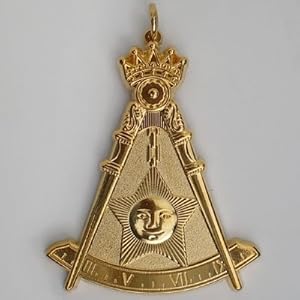The world of craftsmanship and design is a fascinating interplay of skill, artistry, and tradition. Within this realm, Masonic rings hold a unique significance, particularly the 14th Degree Grand Elect Masonic Ring. This article delves into the intricate craftsmanship and design elements that characterize this emblematic piece of jewelry, exploring its historical context, symbolic meanings, and the artistry involved in its creation.
Understanding the Masonic Tradition

Freemasonry is one of the world’s oldest and largest fraternal organizations, with roots tracing back to the late 16th to early 17th century. Its members, known as Masons, engage in various rituals and ceremonies that emphasize moral and ethical development. The 14th degree, specifically, is among the higher degrees of the Scottish Rite of Freemasonry, which focuses on personal growth and enlightenment.
- Historical Context: The Scottish Rite emerged in the early 18th century, offering additional degrees beyond the initial three of Craft Masonry.
- Symbolism: The 14th degree, known as the “Grand Elect Knight,” emphasizes the values of honor and integrity.
- Rituals: Members of this degree undergo specific ceremonies that reinforce their commitment to these principles.
The Craftsmanship Behind the 14th Degree Grand Elect Masonic Ring

The craftsmanship of the 14th Degree Grand Elect Masonic Ring is a testament to the skill and dedication of artisans. Each ring is typically crafted from precious metals such as gold or silver, and often features intricate designs that symbolize various Masonic principles.
Materials Used
Craftsmen select high-quality materials to ensure that each ring is not only beautiful but also durable. Common materials include:
- Gold: Often used for its luster and prestige, gold rings signify value and tradition.
- Silver: A more affordable alternative, silver rings still offer elegance and a classic appearance.
- Enamel and Gemstones: Many rings feature enamel inlays or gemstones, which add color and depth to the design.
Design Elements

The design of the 14th degree ring is rich with symbolism, often incorporating various Masonic symbols that resonate with the values of Freemasonry.
- Square and Compasses: This universal symbol of Freemasonry represents morality and the importance of balance in life.
- 14th Degree Emblem: The emblem often features elements specific to the 14th degree, such as the double-headed eagle, symbolizing the duality of man.
- Inscription: Many rings are inscribed with the names of the lodge or specific phrases that hold significance to the wearer.
The Importance of Design in Craftsmanship
Design plays a crucial role in craftsmanship, particularly in jewelry making. The aesthetic appeal of a piece can enhance its value and significance. In the context of Masonic rings, the design is not merely ornamental; it conveys deep meanings and values.
Aesthetic Considerations

The visual appeal of the 14th Degree Grand Elect Masonic Ring is paramount, as it is often worn at formal events and gatherings. Key aesthetic considerations include:
- Proportions: A well-proportioned ring ensures comfort while making a bold statement.
- Finish: The finish of the ring, whether polished or matte, can change its entire appearance and feel.
- Color and Contrast: The use of contrasting colors in gemstones or enamel can highlight specific design features.
Functional Considerations

While aesthetics are important, functionality cannot be overlooked. The 14th Degree Grand Elect Masonic Ring must be comfortable to wear daily while still maintaining its symbolic presence.
- Comfort Fit: Many modern rings are designed with a comfort fit, allowing for easier wear.
- Durability: High-quality craftsmanship ensures that the ring withstands daily wear and tear.
Case Studies: Notable Craftsmanship in Masonic Rings

To illustrate the importance of craftsmanship and design, we can look at notable examples of Masonic rings that embody these principles effectively.
The Ring of General Albert Pike
General Albert Pike, a prominent figure in American Freemasonry, was known for his elaborate Masonic ring. His ring featured intricate designs that included the double-headed eagle and was made of high-quality gold, showcasing both craftsmanship and symbolic depth.
The Ring of Franklin D. Roosevelt
Another notable figure, Franklin D. Roosevelt, wore a Masonic ring that represented his commitment to the values of Freemasonry. The ring’s design was simple yet elegant, reflecting his personality and the era’s style.
The Cultural Impact of Masonic Rings
Masonic rings, particularly the 14th Degree Grand Elect Masonic Ring, hold cultural significance beyond their aesthetics. They serve as a symbol of identity and belonging among members, fostering a sense of community and continuity.
- Community: Wearing the ring signifies a shared commitment to Masonic values among members.
- Legacy: Many Masons pass down their rings through generations, serving as a familial link to Masonic tradition.
- Recognition: The ring often acts as a badge of honor, recognized among Masons worldwide.
The 14th Degree Grand Elect Masonic Ring is more than just a piece of jewelry; it is a representation of high craftsmanship and design intertwined with deep symbolism and tradition. From the materials used to the intricate designs that convey Masonic values, each ring tells a story of dedication, artistry, and brotherhood. As we explore the significance of these rings, we appreciate the skill involved in their creation and the cultural impact they have within the Masonic community.
In summary, the craftsmanship and design of the 14th Degree Grand Elect Masonic Ring reflect a rich history and a commitment to the values of Freemasonry. Whether worn as a symbol of personal achievement or as a connection to a broader community, these rings embody the essence of what it means to be a Mason. Their enduring appeal lies in their ability to combine beauty, meaning, and tradition, making them a significant part of Masonic culture.


